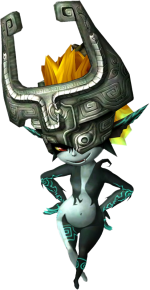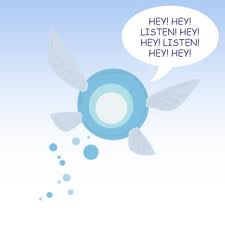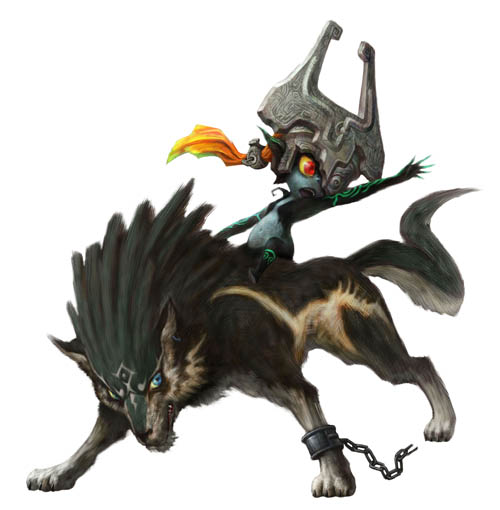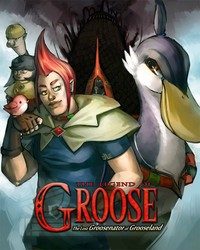Part 46: Okami vs. The Legend of Zelda
Ahem. Right. So I promised something special today, did I not? Well, it's not an update, sorry. I have a discussion topic!
Discussion Topic: Okami vs. That other Adventure Game with a Silent Protagonist
Today, in honor of the release of the Legend of Zelda: Skyward Sword, I’m doing a Zelda-themed discussion! Since I’m currently too busy playing it to update!

Okami bears many similarities to the mega-popular action/adventure series, The Legend of Zelda. In fact, I often make references to Zelda games in my commentary.
Now, both Okami and the Zelda series belong to the same genre, so naturally they share many common elements. Given the popularity of Zelda, the comparison is inevitable. Anyone who has played a Zelda game will notice the similarities.
But just how similar are they? And do these similarities work to the detriment of either game? Well, that’s today’s discussion topic!
(‘Spergy wall of text incoming!)
Okami is especially similar to Twilight Princess, which was released at about the same time (though Okami’s visual style is more similar to Wind Waker). In both games, the world starts out dark and gloomy. In Twilight Princess, the Twilight realm has invaded the real world, robbing it of sunlight and forcing the residents to live as ghosts. In Okami, there are gigantic cursed zones that cover the land in darkness, render your Celestial Brush useless, and turn the populous into statues. In either case, the darkness is held at bay by guardians: in Twilight Princess- the Light Spirits, and in Okami- the Guardian Saplings. Through your efforts, you are able to restore the guardians to power, drive off the darkness and restore the world to its natural state.

Ordona, one of the Light Spirits
Both games center around massive overworld areas (e.g. Hyrule Field and Shinshu Field), with sub-areas containing one or more dungeons. You delve into these dungeons, collect treasure, and defeat the dungeon’s boss. As you acquire new equipment and abilities, you are able to access parts of the hub, or new hubs, that were impossible to get to before, thus allowing you to go to a new area, beat the dungeon boss, etc.
Both games have a sidekick character who dispenses advice and offers tutorials and gameplay hints. Issun also serves as Amaterasu’s voice, since she, like her green-clad counterpart, never speaks. In Twilight Princess, Link even spends portions of the game as a wolf.

Midna, the sidekick character from Twilight Princess

Hey, at least Issun's not this obnoxious:

Link's wolf form from Twilight Princess
So, yes. The two games are very similar, because they’re from the same genre. In fact, the creators of Okami admit to being fans of the Zelda series and drawing inspiration from it, so the similarity is definitely intentional!
However, is Okami simply a Zelda clone? In my opinion, no.
The Legend of Zelda is, of course, the defining, and pioneer, game of the adventure genre. The series has been around for 25 years now and is hugely popular worldwide. Okami can’t boast anywhere near the sales figures and popularity of the Zelda franchise. However, I would argue that Okami is easily at least as good, if not better, than any Zelda game. It’s definitely better than Twilight Princess.
Now, don’t get me wrong here. I adore the Zelda series. I will continue to play, and enjoy, Zelda games as long as Nintendo keeps making them (Skyward Sword, hell yeah!). The series does a lot right. Zelda games are well designed, they’ve progressed by leaps and bounds in graphics and gameplay over the years, and they’re just plain fun to play! But, all the same, you have to admit that the games are terribly formulaic, sadly to the point of becoming stale. You always know exactly what to expect from a Zelda game. Except for Zelda II, Nintendo has never deviated from the series’ tried and true formula. They would do so at their own peril (as evidenced by the mixed reception of slightly oddball Zelda games like Wind Waker and Spirit Tracks).
In pretty much every Zelda game, you go into a new area, enter a dungeon, and collect an item. That item is the key to getting through the rest of the dungeon and defeating the dungeon boss. Afterwards, you use that item to access areas of the world map, and treasures, that you couldn’t reach before. The puzzles also have remained more or less the same. Who doesn’t know the mantra for solving puzzles in Zelda: defeat every enemy, push every block, and look for a switch to press?
That’s not to say that The Legend of Zelda doesn’t innovate at all! The collection of items and weapons changes from game to game, and they’re probably the most innovative thing about Zelda games. Even then, there are several staple items that are found in every game (which are usually tweaked a little –e.g. the Gale Boomerang). The series has also successfully made the transition from 2-D to 3-D, while still staying true to its roots (and there are still top-down, 2-D Zelda games being released). Innovation in The Zelda series just tends to be a bit conservative. But hey, maybe this is a good thing? At least the games are consistent (and consistently good)!

Gale Boomerang, so fun, so underutilized
(Note: Skyward Sword is exceptional in this regard. It bucks a lot of these trends, but I hadn’t played it yet when I wrote this.)
Now, Okami uses many of the same elements as The Legend of Zelda, but also expands on, and adds to them. Somehow, despite having similar structure, it never feels stale.
For one thing, Okami’s art style sets it apart. The game looks like a moving painting. If you notice in the intro cinematic, the scenes pan side to side, as if they were being unrolled from a scroll. The bestiary in the game also scrolls in a similar fashion. And of course, loading screens and scene transitions are preceded by a sweep of a scroll opening and closing. In the PS2 version, the background is even textured to look like paper. The result is highly stylized, and yet detailed, environments. Personally, I think the overall effect is gorgeous, but some people I’ve met don’t agree with me (my husband among them).
Adding to the painting motif, there is of course the game’s central mechanic: the Celestial Brush. It’s a wonderfully innovative element, superficially similar to the ocarina in Ocarina of Time and Majora’s Mask. Like the ocarina, you can use it to control the weather, warp from place to place, and solve puzzles. However, unlike the ocarina, the Celestial Brush also allows you to defeat enemies and interact with NPCs and the environment in far more depth than you can in OoT or MM. The Brush really adds a whole new level to the game. Without it, this would just be a pretty Zelda clone.

This thing has nothing in the Celestial Brush!
Well, perhaps not quite. Okami has more going for it besides a unique visual style and innovative game mechanic. For one, like the Zelda series, it has fantastic music. I’ll post soundtrack links here as I update. Give them a listen. I think you’ll find that the music is really top quality, and fits the mood perfectly. Aside from that, one thing Okami definitely does better than Zelda is the cast of characters. NPCs in the Zelda series tend to be rather… blah. They have a few quirks, but you don’t get much of a sense that they’re real people, and they’re very much in the background. There are exceptions, of course. Most of the characters in Majora’s Mask are quite dynamic and feel very much alive. Salvatore from Windwaker, Malo from Twlight Princess, Linebeck from Phantom Hourglass, and Groose from Skyward Sword are all delightfully memorable.

Dare to dream
Now, imagine if nearly all the characters were of such high quality? That’s Okami. Okami’s cast of characters is enormous, so I’ll limit myself to discussing a few of them. First, Issun. On the surface, and through the early parts of the game, Issun is merely your sidekick, in-game tutorial machine, and Ammy’s spokesperson. He performs many of the same functions as Navi, Tatl, and Midna, though he’s more similar to Midna than the other two. Like Midna, Issun has a distinct personality and his own story arc. Throughout the game, he transcends being a mere sidekick, becoming a fully-fleshed out character. He also develops and changes, even moreso than Midna. But even she has much more development than Navi or Tatl.
Then there’s Susano. Susano probably grows the most of any character in the entire game, and he’s an NPC! His story arc parallels your own. He visits many of the same locations you do and encounters similar hardships. His journey changes him profoundly. Really, he has some of the best development of any character (much less NPC!) in any game I’ve ever played, and a few books too! Keep a close eye on Susano as we go through the game.
Lastly, the story. The story in Zelda games tends to be something that is Just There. You know it exists, but you don’t really care, because Zelda games are about the exploration and puzzles and collecting stuff. (Plus, the story is usually “Ganon/Vaati/whoever is doing evil stuff. Go stop him and save the princess or whatever. Go collect three things/seven things. You’ll find them in dungeons. Oh, and you’ll probably need the Master Sword/Four Sword sometime.”) Okami’s story… well. For one thing, it’s deeply rooted in Japanese mythology and folklore. The central myth, “The Legend of Orochi,” is also extremely similar to “Saint George and the Dragon.” But there are a lot of side stories, involving the myriad NPCs you encounter throughout the game. In that sense it’s similar to Majora’s Mask, in that all the NPCs have their little side plots. Unlike Majora’s Mask, you encounter many of these side plots during the normal course of the game, and not just as a sidequest. The story has mystery, betrayal, redemption, romance… it has everything.
Truly, this game is a joy to play. I hope you come to enjoy it as much as I have!
Glazuis posted:
I actually kinda like Gi. Somebody's got to protect the big crybabies here from monsters. ...and also themselves.
I do too. In fact, one thing I really like about this part in the game is that all of the three remaining Canine Warriors have reasons for doing what they do. We'll see the motivations of the other two soon. As for Gi/Take, I think he truly felt he could do the most good by staying where he was. Feeling beholden to people who took you in and wanting to protect them in turn are perfectly understandable!